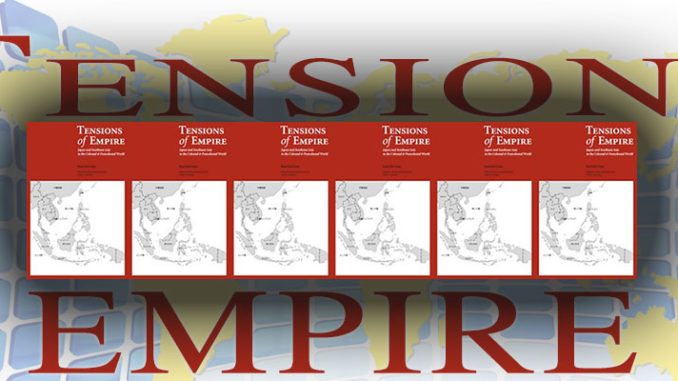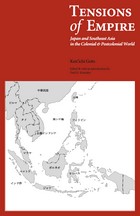
Ken’ichi Goto, Tensions of Empire: Japan and Southeast Asia in the Colonial and Postcolonial World, Athens: Ohio University Press, 2003, xxii + 291pp. Notes, Index. ISBN 0-89680-231-0
No region like Southeast Asia has been so deeply shaped by the external forces of the various big powers in the world. In Asia such forces are China, India, Japan and the Middle East; beyond Asia are Europe and the USA. Unlike Western colonialism, Japanese serious interest in Southeast Asia started as rather late as the mid-1930s and Japanese occupation was rather short lasting for three and half years only. Yet, its political and social impacts were so profound that Southeast Asia was hence tremendously reshaped all of sudden. Even nowadays Japanese legacy remains a hot source of public controversy both in East Asia and in Southeast Asia. Unlike China’s interaction with Southeast Asia, which was characterized, at least in modern times, by the elements from the below through the massive migration beyond Chinese government’s control from the Southeastern China coast. Yet, in contrast, Japanese relation with Southeast Asia was characterized, coerced, and implemented by the imperial establishments from the above. From the perspective of a Japanese professional historian, the book under review is an important contribution to the better understanding of Japan and Southeast Asia in the colonial and postcolonial world. Particularly, for outside readers who have no access to Japanese publications, it is a welcome balanced-account between the Japan-centric approach and the Allied viewpoints in the West.
Rather than a monographic study as originally projected, Tensions of Empire is a collection of articles that were written by Ken’ichi Goto, a leading Southeast Asian historian of Waseda University, mainly in the 1990s and the early part of this century. Yet, the book is well-structured and amazingly integrated as a cohesive whole. In the volume, in line with the time frame, Goto starts by tracing the changing Japanese perceptions of Southeast Asia in the prewar 1930s and ends by discussing contemporary Japanese views of the occupation of Southeast Asia in the postwar period up to 1990s. Centering on the thematic linkage of Japan and Southeast Asia, Goto contextualizes his presentations in the wider settings of international relations in terms of the international hegemony on the one hand and of the Japanese Northward Advance in East Asia on the other. Specifically, Goto focuses on the Japanese in Southeast Asia, Indonesians in Japan, and the legacy of the war in Southeast Asia. Attention is especially paid to the actions of ordinary people from below on both sides, but not as a conflict fought against the enemies. The book consists of twelve chapters and is divided into “three sets of understandings of the war and occupation, those of the Japanese, the Allied powers, and the countries of Southeast Asia” (p.xxii). Going a step further, Goto approaches his study in depth by locating a cluster of well-structured case studies at various levels, such as Portuguese Timor, key personalities of Japanese and Southeast Asian elites, students associations and training program, and decolonization. As Paul Kratoska beautifully summarizes in the introduction:
The present volume makes no attempt to provide a comprehensive account of the period, or of Japan’s relations with Southeast Asia as a whole. Rather, it offers insights into relations between Japan and Southeast Asia at various levels and at different times between the 1930s and the postwar era. The author says little about the large issues that drove the conflict –– Japan’s need for natural resources and outlets for trade, the struggle to control large parts of East and Southeast Asia, and the clash of ideologies — but focuses instead on individuals, looking at the ideas that motivated them, the goals they hoped to achieve, and the success or failure that attended their efforts. The essays discuss famous figures of the period, including Tōjō Hideki, Sukarno and Mohammed Hatta, Ba Maw, and Jose P. Laurel, but also consider the lives and activities of Southeast Asian students in Japan before and during the war, and of ordinary Japanese in Southeast Asia. The authors is often critical of the Japanese, highlighting hypocrisy and betrayals on the part of various officials, overly ambitious plans, failures to understand or respect the peoples and cultures of Southeast Asia, and racial arrogance, but he also shows something of the thinking that lay behind Japanese actions as well as the relentless logic of the situation. (p.xx)
 Until 1936 Japanese foreign policy had been dominated by the Northward Advance, in which the neighboring countries, such as Korea and China, were the top priority. Hence in Southeast Asia, even on the eve of the war, the Japanese community was relatively small, less than 50,000 people in total, and more than half was concentrated in the Philippines. This is in a sharp contrast with the Chinese and even the Indians. Unlike Japanese immigrants’ in East Asia who had close official backgrounds, most Japanese in Southeast Asia came “from the lower strata of Japanese society: prostitutes, farmers, fishermen, commercial immigrants, and workers who labored at various industrial sites”.(p.10) Following the southward-advance policy in 1936 when Japan first showed serious interest in Southeast Asia, as the author argues, Japanese perceptions were featured as “the concepts of political dominance and complementary economic relations and a sense of cultural supremacy. More concretely, Japan viewed Southeast Asia as an area possessing great wealth in the form of unexploited resources that Japan needed, as a region politically suffering under the harsh rule of Western colonialism, and as an area where the people had only reached a very low stage of cultural development”.(p.23)
Until 1936 Japanese foreign policy had been dominated by the Northward Advance, in which the neighboring countries, such as Korea and China, were the top priority. Hence in Southeast Asia, even on the eve of the war, the Japanese community was relatively small, less than 50,000 people in total, and more than half was concentrated in the Philippines. This is in a sharp contrast with the Chinese and even the Indians. Unlike Japanese immigrants’ in East Asia who had close official backgrounds, most Japanese in Southeast Asia came “from the lower strata of Japanese society: prostitutes, farmers, fishermen, commercial immigrants, and workers who labored at various industrial sites”.(p.10) Following the southward-advance policy in 1936 when Japan first showed serious interest in Southeast Asia, as the author argues, Japanese perceptions were featured as “the concepts of political dominance and complementary economic relations and a sense of cultural supremacy. More concretely, Japan viewed Southeast Asia as an area possessing great wealth in the form of unexploited resources that Japan needed, as a region politically suffering under the harsh rule of Western colonialism, and as an area where the people had only reached a very low stage of cultural development”.(p.23)
In the contexts of the colonial rule in Southeast Asia and of the Japanese quest for an equal treatment in the Western family, the relationship between Japan and Southeast Asia was very complex, characterized by alternating cooperation, suppression, submission and resistance. Or, the relationship is something like that “the two parties were in the same bed with different dreams,” as coined by Goto. (p.79) This was typically manifested both in the perceptions of Tōjō Hideki, Japanese Prime Minister and concurrently War Minister, and in the strategies of Southeast Asian local elites, such as Sukarno and Mohammed Hatta of Indonesia, Ba Maw of Burma, and Jose P. Laurel of Philippines. Therefore, it witnessed the different patterns of Japanese rule in Southeast Asia during World War II: joint administration with such a former colonial state as French Indochina; alliance with a nominal independent state as in Thailand; and the direct military governments for the rest of Southeast Asia. Such Japan-Southeast Asia relation patterns continue to be examined in depth in the following case studies of student association and exchanges in prewar and wartime Japan, the Sumarang Incident/Battle, the story of Japanese “Abdul Rahman”, and the decolonialization process. It should be pointed out that, due to the author’s own expertise, most case studies are concentrated on Indonesia, which consists of about six chapters and 60 percent contents of the volume. Nevertheless, to some extent such sharp but imbalanced focus of the specific Japan-Indonesia relation complements the overall Japan-Southeast Asia coverage.
Japan justified its occupation of Southeast Asia beautifully in terms of Asianism and liberation from the Western colonialism and played cultural, ideological, racial and colonial conflicts “between Asia and Europe, of colored people versus while, and of non-Christian nation versus Christian” ( p.11). While, on the contrary, throughout the volume, Goto has argued that:
The true purpose of the Japanese occupation of Southeast Asia was to control the whole of the region because it was a major source of the raw materials and human resources needed to carry out Japan’s war aims. The liberation of Southeast Asia from Western colonial rule was only a façade used to lend respectability and legitimacy to this effort. Some of the measures taken in Southeast during the occupation incidentally did prove beneficial, but that was only incidental, and due respect must be given to the political skills and social capabilities of the occupied peoples, who used the opportunities created by the Japanese invasion to further their own national interests. (p.291)
Tensions of Empire is a well-written and solid piece of scholarship grounded in the formidable research. With admiration, Goto has exhibited a masterly skill of narratives with highly readable clarity in a sophisticate structure. It touches upon various fields of interests such as Japan, Southeast Asia, East Asia, international relations, colonialism, decolonialization and nation-building and should be of interest to a wide- range of readerships.
Wu Xiao An
Associate Professor, Department of History, Peking University
Kyoto Review of Southeast Asia Issue 8-9 (March 2007)
